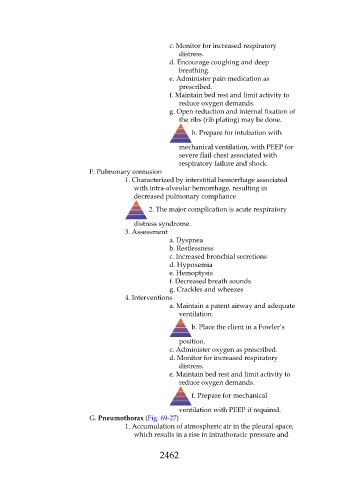Page 2462 - Saunders Comprehensive Review For NCLEX-RN
P. 2462
c. Monitor for increased respiratory
distress.
d. Encourage coughing and deep
breathing.
e. Administer pain medication as
prescribed.
f. Maintain bed rest and limit activity to
reduce oxygen demands.
g. Open reduction and internal fixation of
the ribs (rib plating) may be done.
h. Prepare for intubation with
mechanical ventilation, with PEEP for
severe flail chest associated with
respiratory failure and shock.
F. Pulmonary contusion
1. Characterized by interstitial hemorrhage associated
with intra-alveolar hemorrhage, resulting in
decreased pulmonary compliance
2. The major complication is acute respiratory
distress syndrome.
3. Assessment
a. Dyspnea
b. Restlessness
c. Increased bronchial secretions
d. Hypoxemia
e. Hemoptysis
f. Decreased breath sounds
g. Crackles and wheezes
4. Interventions
a. Maintain a patent airway and adequate
ventilation.
b. Place the client in a Fowler’s
position.
c. Administer oxygen as prescribed.
d. Monitor for increased respiratory
distress.
e. Maintain bed rest and limit activity to
reduce oxygen demands.
f. Prepare for mechanical
ventilation with PEEP if required.
G. Pneumothorax (Fig. 69-27)
1. Accumulation of atmospheric air in the pleural space,
which results in a rise in intrathoracic pressure and
2462

